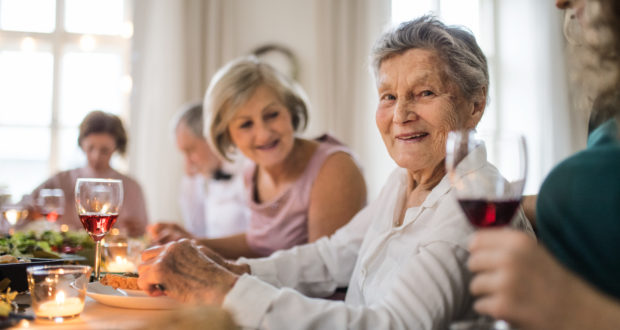It's a well-known fact that many baby boomers enjoy a glass of wine with their dinner – but what are the reasons behind it, and how will aged care homes fare as this generation enters aged care?
Surveys show that the generation aged between 57 and 75 are most likely to drink daily, with those over 70 taking the lead (21%).
Boomers in their 50s (21%) and 60s (17.4%) are also at a greater lifetime risk due to higher alcohol intake than the rest of Australia.
Associate Professor Caroline Salom from the University of Queensland expects boomers to continue to be regular drinkers when they enter nursing homes.
"Their drinking habits have been very long established by now because we normally form those routines in our 20s and 30s," she says.
Boomers have strongly voiced their displeasure with the current aged care system, pushing for reform to keep their freedom and independence, and a call to change alcohol regulations doesn't seem far-fetched.
The government has left the choice in policymaking up to the provider whether to serve alcohol or not, which they can formulate in their additional services.
Most residential care homes agree that the option to drink alcohol fits into the person-centred approach, though each follows its own regulations.
Some providers allow mini-bars in residents' rooms and provide alcoholic drinks during Happy Hour and special events; others serve only alcohol after the approval of a medical officer.
Caroline says serving alcohol to older people and residents could be a delicate situation with many factors to consider.
"The funny thing about alcohol is that nothing's ever really straightforward," she says.
"We know that risks associated with drinking alcohol will increase as we age.
"Which is, unfortunately, one of those things that happen – our bodies start to betray us as we get a bit older."
Older people often eat less, weigh less and may have cognitive changes or diseases, such as dementia, that inhibit their ability to cope with alcohol consumption.
Most residents are also on multiple different medications, which may negatively respond to alcohol.
And then there are the high risks of falls and injuries in nursing homes where alcohol could worsen someone's sense of balance.
"As we get older, our metabolism slows down, and the health of our liver might become poorer, so it takes longer to process alcohol and it may do more damage," Caroline says.
"Our body composition also changes as we age, which affects our ability to process the alcohol and get rid of the toxins involved."
Interestingly, Caroline says that boomers have not drastically increased their alcohol intake – it just never changed.
Caroline explains that the amount they drink is not considered at a greater risk level than it would've been when they were younger.
"Older people are less aware of the guidelines around lower risk drinking.
"That's probably because the current guidelines that are in existence in Australia were first introduced in 2005.
"So for those born in the '50s, their drinking patterns were well-established by the time the government put strong guidelines in place."
In fact, the first authoritative population-wide advice about sensible drinking only started coming out in the late 1980s.
And even in the '80s, the notion of sensible drinking involved a lot more alcohol than what we would consider lower-risk drinking now.
"I was looking at an old alcohol campaign, and they were saying that five pints of beer were too much, but two to three pints two to three times a week is moderate," Caroline says.
"If you translate those three pints of beer someone might have on a day, assuming they're full strength, it comes to nearly five standard drinks in Australian terms."
The current guidelines recommend no more than ten standard drinks per week and no more than four on any day.
So, someone who'd drink three pints of beer three times a week equals 14.5 standard drinks, comparable to a whole week-and-a-half's worth of drinking now.
"Our understanding of the risks associated with alcohol and our ability to put more reliable numbers on those risks has evolved a lot over time," Caroline says.
"So those who've been effectively drinking alcohol for a much longer period of time won't necessarily have kept up with that advice."
Interestingly, AIHW data revealed a trend where the proportion of young adults between 18–29 who abstained from alcohol has more than doubled since 2019.
In the survey, younger people said safekeeping their health had been their primary reason behind drinking less or stopping drinking alcohol altogether.
Yet, the proportion of those aged over 70 and abstaining from alcohol has declined from 32 per cent in 2001 to 28 per cent in 2019.
A 2020 survey even found that Australians aged between 64 and 74 were drinking double the amounts of alcohol than younger people.
"It may be that those of us who are a bit younger are used to seeing alcohol-awareness campaigns and recognise them, whereas older people don't pay much attention," Caroline says.
"Or perhaps because of the later introduction of the guidelines – they might not be of the mindset that they need to think about limiting their alcohol intake."
Regardless of boomers' drinking behaviour, the sector may be bracing itself for significant changes in the future as the 47th parliament pushes for two new aged care bills.
Caroline says the way we perceive alcohol is hard to change as we associate drinking with a lot of positive outcomes.
"In Australia, alcohol has a really strong association across the board with things we perceive positively, such as socialising, and that's one of the big challenges for communicating the risks around drinking," she says.
Do you have an idea for a story?Email [email protected]
 Aged Care Insite Australia's number one aged care news source
Aged Care Insite Australia's number one aged care news source

